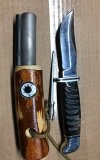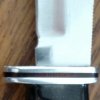- Joined
- Mar 8, 2008
- Messages
- 25,891
Some fundamental misconceptions here. It's very possible to sharpen a choil-less knife without causing a recurve, AND it's possible to get the very base of the blade without hitting the plunge line. The former will require tilting the blade up a little bit to focus your efforts on the recurved portion. The rest of the blade will be floating parallel to the stone until you've ground away the projecting heel and brought it level with the rest of the edge. To deal with the latter issue, one simply needs to approach the abrasive at a slant to allow it to contact just at the edge, and not the region above it.




